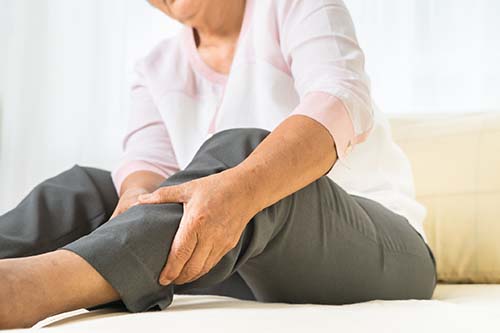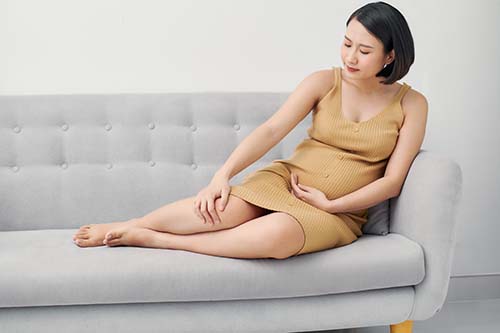Venous reflux disease is a common condition affecting the leg veins in which the normal mechanisms that help push blood back to the heart, such as the vein valves and the pumping effects of the calf muscles, are impaired. As a result, blood flow becomes turbulent and eventually backs up and can even flow in reverse.
As venous reflux progresses it leads to a condition known as venous insufficiency, whereby the veins are unable to maintain sufficient blood flow to keep up with the flow of blood coming into them. The terms venous reflux and venous insufficiency are often used interchangeably. This chronic condition causes a number of painful symptoms and can lead to a variety of undesirable and challenging health complications.

Symptoms of Venous Reflux Disease
Venous reflux makes blood flow sluggish and inefficient, causing blood pressure to build up in the veins. Symptoms of venous reflux are usually brought on by prolonged sitting or standing and relieved by rest. Increased venous blood pressure prompts your body to send you several unpleasant warning signs to let you know that there is a problem that needs to be addressed. These include:
- Swelling: Elevated blood pressure in the veins of the lower legs causes fluid to leak out of the veins into surrounding tissues, causing swelling.
- Dull, Aching Pain: As pressure accumulates in the legs from the swelling it causes the legs to ache.
- Heavy Sensations: Feelings of heaviness can also occur due to swelling and pressure.
- Cramping: As venous blood flows out of the legs slows, the ability of the veins to receive fresh, oxygenated blood diminishes. As a result, the leg muscles may cramp due to poor oxygenation.
If left untreated, as venous reflux disease progresses, advanced signs and symptoms may appear, including:
- Varicose Veins: Varicose veins are swollen, discolored, distended, or twisted veins just beneath the skin’s surface, often appearing bluish.
- Discoloration of the Skin: Along with leakage of fluids from the veins, increased venous blood pressure can push red blood cells out of the veins. As the cells die, they release hemoglobin, which degrades and takes on a dark, bluish to reddish-brown appearance. This usually appears around the ankles.
- Venous Ulcers: These are open sores on the skin that occur from continued fluid build-up and pressure in the legs, which weakens and erodes the skin. Venous ulcers often occur around the ankles or shins. They are slow to heal and even with diligent treatment can take up to 11 months to fully mend.

Risk Factors for Venous Reflux Disease
While increased venous blood pressure is the direct cause of venous reflux disease, there are other underlying factors that contribute to elevated venous blood pressure. Some of the most significant risk factors include the following[1]:
- Family History of Varicose Veins: Some of the strongest genetic links that increase the risk for venous reflux have to do with genes involved with regulating blood pressure and genes involved in the development of your vascular system[2]. You may also inherit weak valves. Vein valves are made of a protein called collagen. The characteristics of collagen vary slightly from person to person, with some people producing more flexible collagen while others produce a version that is relatively stiffer. If you are in the latter group your valves may be more susceptible to wear and tear and more easily damaged.
- Being Overweight: Obesity is associated with chronic low-grade inflammation, which damages blood vessel linings, leading to further impaired blood flow[3]. Additionally, if you are obese and have venous reflux disease you are more likely to experience venous ulcers[3].
- Being Pregnant: Pregnancy contributes greatly to the increased risk for venous reflux in women. There are several factors unique to pregnancy that are responsible for this increased risk:
- Hormones released during pregnancy, particularly progesterone, make the veins more expandable and this places stresses on veins and makes it more difficult to move blood back to the heart[4].
- The increased blood volume in pregnancy places added physical stress on blood vessels[4].
- As the baby grows, the increased weight within the mother’s pelvis compresses pelvic veins, increasing blood pressure in the leg veins[4].
- Estrogen and progesterone receptors in the large veins of the legs are thought to contribute to the dilation of the veins and impaired function of the vein valves[4].
- Lack of Exercise
There are many important health benefits to be gained by exercising regularly and several of them directly or indirectly improve the health of your veins and decrease your risk for developing venous reflux disease. Exercise improves blood flow in your veins and exercises that use your leg muscles are especially helpful for promoting strength and circulation in the legs. Strong leg muscles promote healthy venous circulation by gently massaging the veins, which helps push blood through them. Also, regular exercise helps you maintain a healthy weight, which can reduce your risk for venous reflux disease by preventing high blood pressure. - Smoking: Smoking significantly increases the risk for venous reflux disease. Smoking damages blood vessels, reduces blood oxygen levels, and promotes inflammation. While both male and female smokers are at risk, one study reported a difference in symptoms between men and women, with swelling being more common in female smokers while skin changes were reported to occur more frequently in male smokers[5].
- Prolonged Standing or Sitting
Both standing and sitting impair return blood flow to the heart. Standing in place hinders blood flow in the legs because the veins must overcome the effects of gravity without the benefit of the muscular pump of the calf muscles, relying only on the valves, which can be faulty. One study found that venous insufficiency among medical operating room personnel and laundry workers, occupations that require a lot of standing with little walking, was as high as 76%[6]. Sitting for long periods of time, in addition to the effects of gravity, also places the hips in a flexed position, which can further impede blood flow, even more so if clothing is tight or binding. - Age: As you age the connective tissues in your veins become weaker and your body’s ability to produce collagen and elastin, the proteins that form these connective tissues decreases, leading to poorer quality structural proteins. As a result, your blood vessels become stiffer and less able to accommodate normal fluctuations in blood flow. Age is also tied to gender in terms of its effect on risk for venous reflux disease, with women experiencing a greater increase in risk as well as more symptoms if they develop venous insufficiency as they age compared to men[7]. Past the age of 65 women have been found to have an 83% chance of having of developing venous insufficiency, about 28% greater likelihood than men of the same age range[7].

How Is Venous Reflux Disease Diagnosed
Venus reflux disease is diagnosed using ultrasound imaging, a painless, non-invasive procedure. Ultrasound can determine the speed of blood flow and the diameter of the blood vessels, showing precisely where the blood flow in your legs is reduced, turbulent, or blocked. An ultrasound imaging study, combined with a thorough health history and physical examination helps your doctor arrive at an accurate diagnosis and choose the best course of treatment for your individual needs.

Treatment Options for Venous Reflux Disease
Empire Vein Specialists offers the most up-to-date treatment options available for venous reflux disease. These procedures permanently eliminate problem veins and the symptoms that go along with them. Depending on your symptoms and what your ultrasound study reveals, one or more of the following treatments may be recommended for you:
- VenaSeal™ uses a medical grade adhesive to block off the affected vein(s) and redirect the flow of blood to healthy veins. VenaSeal™ takes just 20 minutes, and you will be able to walk out of the office after your procedure. Empire Vein Specialists is the #1 provider of VenaSeal™ in the U.S.
- ClosureFast™ uses radiofrequency energy to seal off affected veins. It results in less pain and bruising, and faster recovery time compared to laser therapy. Recovery is rapid requiring only the use of compression stockings for about two weeks[8].
Why Choose Empire Vein Specialists for Treatment
Empire Vein Specialists is the top provider of VenaSeal™, the leading outpatient vein treatment, in the USA. All our physicians are board-certified and specialize in helping people with venous reflux disease. Empire Vein Specialists serves the greater Inland Empire area with three convenient clinic locations including Inland Empire, Riverside, San Bernardino, Moreno Valley, and surrounding areas of California, each fully equipped with state-of-the-art technology. Our Victorville clinic is open to serve the residents in the area. From your initial phone call to follow-up care and beyond, our friendly and helpful staff will answer any questions you may have and provide you and your family members with unparalleled vascular health services.
To schedule a free consultation, please call 1-800-VARICOSE (1-800-827-4267) today.
References
- Chronic Venous Insufficiency. Department of Surgery 2022
https://surgery.ucsf.edu/conditions–procedures/chronic-venous-insufficiency.aspx - Clinical and Genetic Determinants of Varicose Veins. Circulation, 2018. 138(25): p. 2869-2880
https://pubmed.ncbi.nlm.nih.gov/30566020 - Obesity and Lower Limb Venous Disease – The Epidemic of Phlebesity. Phlebology, 2017. 32(4): p. 227-233
https://pubmed.ncbi.nlm.nih.gov/27178403 - Interventions for Varicose Veins and Leg Oedema in Pregnancy. Cochrane Database Syst Rev, 2015. 2015(10): p. Cd001066
https://pubmed.ncbi.nlm.nih.gov/26477632 - Lower Limb Venous Insufficiency and Tobacco Smoking: A Case-Control Study. American Journal of Epidemiology, 2002. 155(11)
https://www.ncbi.nlm.nih.gov/pubmed/12034579 - The Influence of Environmental Factors in Chronic Venous Insufficiency. Angiology, 2003. 54 Suppl 1: p. S19-31
https://pubmed.ncbi.nlm.nih.gov/12934754 - The Influence of Age and Gender on Venous Symptomatology. An Epidemiological Survey in Belgium and Luxembourg. Phlebology, 2016. 31(5): p. 325-33
https://pubmed.ncbi.nlm.nih.gov/26036248 - Outcome of Closurefast Radiofrequency Ablation for Large-Diameter Incompetent Great Saphenous Vein. Ann Surg Treat Res, 2019. 96(6): p. 313-318
https://pubmed.ncbi.nlm.nih.gov/31183336